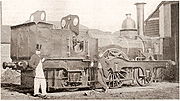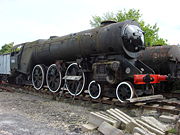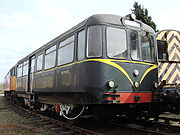
Colne Valley Railway
Encyclopedia
The Colne Valley Railway is a heritage railway
based at Castle Hedingham Station, near Halstead
in Essex
, England
. The railway consists of a mile-long running line, with a fully reconstructed station, signal box
and railway yard. Despite its short length, the CVR is home to three ex-mainline steam locomotives and holds Pullman
dining services on a monthly basis.
As of 2011, there is hope one day the line could extend towards Yeldham as the old train station site has recently been cleared for a path and could also possibly enough space for a future extension, once funding begins and finances allow (plus, extending from a mile-long to about 2 miles).
 The railway occupies part of the former Colne Valley and Halstead Railway
The railway occupies part of the former Colne Valley and Halstead Railway
(CVHR), which opened in stages between 16 April 1860 and 10 May 1863. This part of the railway was a through line from to Wakes Colne.
The line continued to remain open until 30 December 1961, when passenger traffic ended. In 1965, freight traffic ended and the line was demolished a year later.
Although originally a main line railway, the track was taken up in the late 60s, during the Beeching axe
era, so when the railway was purchased there was no remaining infrastructure. The original Hedingham station was one mile away and was taken down carefully brick by brick. The bricks were numbered so that it could be easily and correctly reassembled on the preservation site.
The Hedingham signal box came from (see http://www.flickr.com/search/?q=Cressing%20Signal%20Box&w=26359504%40N08). The timber top half (first floor) was saved for preservation and remounted on a new higher (ground floor) brick base re-constructed for it. The bridge crossing the River Colne came from Earls Colne in 1982.
Recently/Lately, the old station site at Yeldham has been cleared for a path, but there could be enough space for a future extension of the heritage route once funding begins and finances allow (plus the old platforms would require renovation and further restoration and track re-laying).



See CVRPS site for latest position
Heritage railway
thumb|right|the Historical [[Khyber train safari|Khyber Railway]] goes through the [[Khyber Pass]], [[Pakistan]]A heritage railway , preserved railway , tourist railway , or tourist railroad is a railway that is run as a tourist attraction, in some cases by volunteers, and...
based at Castle Hedingham Station, near Halstead
Halstead
Halstead is a town and civil parish located in Braintree District of Essex, England, near Colchester and Sudbury. It has a population of 11,053. The town is situated in the Colne Valley, and originally developed on the hill to the north of the river...
in Essex
Essex
Essex is a ceremonial and non-metropolitan county in the East region of England, and one of the home counties. It is located to the northeast of Greater London. It borders with Cambridgeshire and Suffolk to the north, Hertfordshire to the west, Kent to the South and London to the south west...
, England
England
England is a country that is part of the United Kingdom. It shares land borders with Scotland to the north and Wales to the west; the Irish Sea is to the north west, the Celtic Sea to the south west, with the North Sea to the east and the English Channel to the south separating it from continental...
. The railway consists of a mile-long running line, with a fully reconstructed station, signal box
Signal box
On a rail transport system, signalling control is the process by which control is exercised over train movements by way of railway signals and block systems to ensure that trains operate safely, over the correct route and to the proper timetable...
and railway yard. Despite its short length, the CVR is home to three ex-mainline steam locomotives and holds Pullman
Pullman train (UK)
Pullman trains in Great Britain were mainline luxury railway services that operated with first-class coaches and a steward service, provided by the British Pullman Car Company.-Origins:...
dining services on a monthly basis.
As of 2011, there is hope one day the line could extend towards Yeldham as the old train station site has recently been cleared for a path and could also possibly enough space for a future extension, once funding begins and finances allow (plus, extending from a mile-long to about 2 miles).
History

Colne Valley and Halstead Railway
The Colne Valley and Halstead Railway is a closed railway between Haverhill, Suffolk and Chappel and Wakes Colne, Essex, in England.-History:...
(CVHR), which opened in stages between 16 April 1860 and 10 May 1863. This part of the railway was a through line from to Wakes Colne.
The line continued to remain open until 30 December 1961, when passenger traffic ended. In 1965, freight traffic ended and the line was demolished a year later.
Preservation
The land was purchased in 1973 and the preservation society was formed in 1974. The first steam locomotive to arrive on site was No.WD190 shortly followed by No.72. Members of the preservation society began to operate the locomotives on a short section of line which attracted public attention. Since then the preservation society has evolved into a major tourist attraction and has one of the largest collection of rolling stock in the area.Although originally a main line railway, the track was taken up in the late 60s, during the Beeching axe
Beeching Axe
The Beeching Axe or the Beeching Cuts are informal names for the British Government's attempt in the 1960s to reduce the cost of running British Railways, the nationalised railway system in the United Kingdom. The name is that of the main author of The Reshaping of British Railways, Dr Richard...
era, so when the railway was purchased there was no remaining infrastructure. The original Hedingham station was one mile away and was taken down carefully brick by brick. The bricks were numbered so that it could be easily and correctly reassembled on the preservation site.
The Hedingham signal box came from (see http://www.flickr.com/search/?q=Cressing%20Signal%20Box&w=26359504%40N08). The timber top half (first floor) was saved for preservation and remounted on a new higher (ground floor) brick base re-constructed for it. The bridge crossing the River Colne came from Earls Colne in 1982.
Recently/Lately, the old station site at Yeldham has been cleared for a path, but there could be enough space for a future extension of the heritage route once funding begins and finances allow (plus the old platforms would require renovation and further restoration and track re-laying).
Motive power

Steam locomotives
- LMS 4-6-0 Class 5MT nos. 45163 and 45293. Both under restoration.
- SR 4-6-2 Merchant Navy ClassSR Merchant Navy classThe SR Merchant Navy class , was a class of air-smoothed 4-6-2 Pacific steam locomotives designed for the Southern Railway of the United Kingdom by Oliver Bulleid...
no. 35010 "Blue Star". Static display awaiting restoration. - WD 0-6-0ST "Austerity" no. 190. Undergoing boiler overhaul.
- AvonsideAvonside Engine CompanyThe Avonside Engine Company was a locomotive manufacturer in Avon Street, St. Philip's, Bristol, England between 1864 and 1934. However the business originated with an earlier enterprise Henry Stothert and Company.-Origins:...
0-4-0ST "Barrington". Static display, awaiting overhaul. - Hawthorne LeslieHawthorn Leslie and CompanyR. & W. Hawthorn Leslie and Company, Limited, usually referred to as Hawthorn Leslie, was a shipbuilding and locomotive manufacturer. The Company was founded on Tyneside in 1886 and ceased building ships in 1982.-History:...
0-4-0ST No 1. Static display. - Andrew Barclay 0-4-0ST No 8 "Victory". Undergoing overhaul.
- RSHRobert Stephenson and HawthornsRobert Stephenson and Hawthorns Ltd was a locomotive builder with works in North East England.-History:The company was formed in September 1937 when Robert Stephenson and Company, which was based in Darlington took over the locomotive building department of Hawthorn Leslie and Company, based in...
0-6-0ST No 60 "Jupiter". Undergoing overhaul.
Visiting steam locomotives
- Castle Donington No.1 is a 1954 built Robert Stephenson HawthornsRobert Stephenson and HawthornsRobert Stephenson and Hawthorns Ltd was a locomotive builder with works in North East England.-History:The company was formed in September 1937 when Robert Stephenson and Company, which was based in Darlington took over the locomotive building department of Hawthorn Leslie and Company, based in...
(7817) 0-4-0ST from the Midland Railway - ButterleyMidland Railway - ButterleyThe Midland Railway – Butterley is a heritage railway, formerly known until 2004 as the Midland Railway Centre, at Butterley, near Ripley in Derbyshire.-Overview:...
she has been at the railway since 2008 and is expected to leave at the end of 2011 hopefully operating on a few santa specials as a goodbye. Operational.
Diesel locomotives

- BRBritish RailBritish Railways , which from 1965 traded as British Rail, was the operator of most of the rail transport in Great Britain between 1948 and 1997. It was formed from the nationalisation of the "Big Four" British railway companies and lasted until the gradual privatisation of British Rail, in stages...
0-6-0 Class 03British Rail Class 03The British Rail Class 03 locomotive is, together with Class 04, one of BR's most successful smaller 0-6-0 diesel-mechanical shunters. The class, numbering 230 examples, was built by British Railways' Swindon and Doncaster works in 1957-1962 and numbered D2000-D2199 and D2370-D2399...
nos. D2041 and D2184 Operational - BR A1A-A1A Class 31British Rail Class 31The British Rail Class 31 diesel locomotives, also known as the Brush Type 2 and originally as Class 30, were built by Brush Traction from 1957-62.- Description :...
no. 31255 Operational - BR Co-Co Class 47British Rail Class 47The British Rail Class 47, is a class of British railway diesel-electric locomotive that was developed in the 1960s by Brush Traction. A total of 512 Class 47s were built at Crewe Works and Brush's Falcon Works, Loughborough between 1962 and 1968, which made them the most numerous class of British...
no. 47771 "Heaton Traincare Depot" (under long term restoration 2/9/2007) - Royal Admiralty 0-4-0 no. YD43 Static display.
- BR 0-6-0 British Rail Class 08, various Nos. None operational.
- Class 121British Rail Class 121Sixteen Class 121 single-car driving motor vehicles were built from 1960, numbered 55020–55035. These were supplemented by ten trailer vehicles, numbered 56280–56289 . They had a top speed of 70 mph, with slam-doors, and vacuum brakes...
DMU, Operational - Class 141British Rail Class 141The British Rail Class 141 was the first production model of the Pacer diesel multiple units.-Description:In the early 1980s British Rail were looking to replace the remaining 1950s first generation Diesel Multiple Units on lightly used branchlines...
Pacer No. 141108, Operational - 1950s diesel railbus, static display
- Andrew Barclay 0-4-0DM No. 349/41 Operational
Diesel multiple units

- BR Class 121British Rail Class 121Sixteen Class 121 single-car driving motor vehicles were built from 1960, numbered 55020–55035. These were supplemented by ten trailer vehicles, numbered 56280–56289 . They had a top speed of 70 mph, with slam-doors, and vacuum brakes...
nos. 55033 and 54287 Operational - BR Class 141British Rail Class 141The British Rail Class 141 was the first production model of the Pacer diesel multiple units.-Description:In the early 1980s British Rail were looking to replace the remaining 1950s first generation Diesel Multiple Units on lightly used branchlines...
unit 141108 (55508+55528) Operational - BR Railbuses no. 79978
Electrical multiple units
- BR Class 422British Rail Class 421The British Rail Class 421 electrical multiple units were built at BR York Works between 1964 and 1972. Units were built in two batches, and were initially introduced on services on the Brighton Main Line. Later units were introduced on services to Portsmouth. These units replaced older Southern...
buffet coach 69318 (ex-unit 2259)
See CVRPS site for latest position

